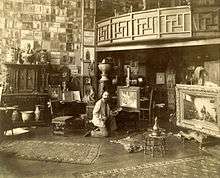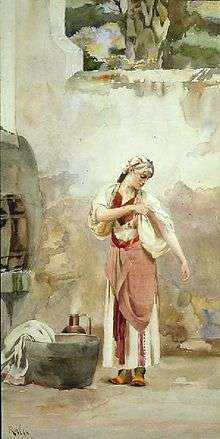Théodore Ralli
Théodore Jacques Ralli or Theodorus Rallis (full name: Theodoros Rallis-Scaramanga; Greek: Θεόδωρος Ράλλης; Constantinople, 16 February 1852 – 2 October 1909, Lausanne) was a Greek painter, watercolourist and draughtsman, who spent most of his working life in France and Egypt.
Théodore Ralli | |
|---|---|
 Théodore Ralli in his Paris studio | |
| Born | Theodoros Rallis-Scaramanga 16 February 1852 Istanbul |
| Died | 2 October 1909 Lausanne |
| Nationality | Greek |
| Education | Jean-Léon Gérôme |
| Known for | Painter and draughtsman |
| Movement | Orientalist |
He painted genre works, portraits, local figures, architectural subjects, interiors with figures and animals. But he is best known for his orientalist paintings.[1]
Biography

He was sent to Paris under the patronage of King Otto of Greece and studied under Jean-Léon Gérôme, French painter and professor at the Ecole des Beaux-Arts, and under Jean-Jules-Antoine Lecomte du Nouy, both known for their orientalist paintings.
Ralli then travelled widely in North Africa and the Middle East, settling for a while in Cairo, Egypt. Here he found his inspiration for the romantic mysticism and suggestive sensuality of his many orientalistic paintings. His other genre paintings were often nostalgic recollections of the life and customs of his Greek homeland, which he portrayed with a delicate and moving reverence. His paintings were elaborated with great attention to detail, with great attention to costumes and facial expressions. The varying light sources in his paintings such as rays of light, candles, or the glowing embers in the fireplace are rendered in soft colours.
Rallis first exhibition was at the Salon in 1875. From 1879 he regularly exhibited at the Royal Academy in London. He was a member of the Société des Artistes Français, where he received an honourable mention in 1885, and a silver medal in 1889 for his whole work He exhibited his paintings in the Salon de Rouen (1897, 1903, 1906 and 1909) and also in Athens during the Olympic Games of 1896. He also served as a member of the competition jury in 1900 at the Exposition Universelle. In 1901 he became a Chevalier of the Légion d’Honneur.[1]
After his death he was slowly almost forgotten. It is telling that his name is not even included in the Grove Dictionary of Art. Most of his paintings are still in private collections. Only a few museums ever purchased his works. A few of his paintings were auctioned in the 20th century, but only obtained modest prices. However lately, his paintings have been rediscovered and are being auctioned at prices that are a tenfold of some years ago, fetching prices from 30,000 to 100,000 euros. On 14 November 2007 a study for the painting “Refectory in a Greek Monastery (Mount Athos)” was auctioned at 200,000 euros at Sotheby's in London. But in January 2008, the actual painting “Refectory in a Greek Monastery (Mount Athos)” (1885) was auctioned at the absolute record price of 670,000 euros to a Greek collector at an auction in Ghent, Belgium.[2] This was followed by the sale of his oil on canvas, titled 'Praying before the communion at Megara' (1890), at the Greek Sale, Bonhams, London W1, held on 25/5/2008. It achieved a staggering hammer price of £600,000. (See Bonhams own catalogue, re. 'The Greek Sale' of 20/5/08, Lot 36, p42-45, four pages of illustration.)
Museums
- Greek National Pinacotheque, Athens (2 paintingsà
- Louvre, Paris (one painting)
- Sydney (one painting)
Selected works
- Praying in a Greek church, Mount Parnassus 1876
- Boa Charmer in the Harem (1882) (oil on canvas)
- Snake Charmer in the Harem (1882) (oil on canvas)
- Wake of the Pasha of Tangier (1884) (oil on canvas)
- Refectory in a monastery (Mount Athos) (1885) (oil on canvas)
- Reclining Odalisk (1885) (oil on canvas)
- Sleeping Concubine (1885) (oil on canvas)
- La Demoiselle (1887) (oil on canvas)
- Evening Prayers (1890) (oil on canvas)
- Praying before the Communion, Megara (1890) (oil on canvas) (presented at the Salon of 1890)
- In the mosque, 1891
- Seamstress (1895) (oil on canvas)
- Drama in the Harem (1908) (oil on canvas) (presented at the Salon of 1908)
- Jerusalem
- Before Solomon’s Wall in Jerusalem
- Woman in Arab Interior
- Girls in Orthodox Church
- Benediction (oil on canvas)
- Peasant Woman resting (watercolour and pencil)
- Girl in Church, Candle in Hand (oil on canvas)
- Two camels in the Desert (watercolour heightened with gouache)
- Ah ! Jealous Woman among Jealous Women (oil on canvas)
- The Sultan’s Favourite
- The Offering
- The Bath (oil on canvas)
- Young Beauty (oil on canvas)
- A Greek Beauty (watercolour on paper)
- Portrait of a Greek Girl (Helen of Megara) (oil on panel)
- Two Wise Old Men in Turbans (watercolour)
- Portrait of a Man in Green (oil on canvas on card)
- Sleeping in Church (oil on canvas)
- Entrance to Mary’s Tomb in Jerusalem (watercolour)
- Religious Instruction in an Algerian Mosque (oil on canvas)
- Girl Spinning Wool (oil on panel)
- Portrait of the Artist
See also
Notes
- Rallis Theodoros (1852 Constantinople - 1909 Lausanne) @ National Gallery of Greece
- Het geheim van schilder Théodore Ralli; story in the Belgian newspaper De Morgen, 24 January 2008 (in Dutch).
References
- Benezit, E., Dictionnaire des Peintres, Sculpteurs, Dessinateurs et Graveurs - Librairie Gründ, Paris, 1976; ISBN 2-7000-0156-7 (in French)
External links
